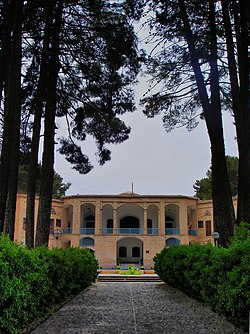Our website is made possible by displaying online advertisements to our visitors.
Please consider supporting us by disabling your ad blocker.
South Khorasan province
South Khorasan Province
Persian: استان خراسان جنوبی | |
|---|---|
 | |
 Location of South Khorasan Province within Iran | |
| Coordinates: 32°48′N 58°11′E / 32.800°N 58.183°E[1] | |
| Country | Iran |
| Region | Region 5 |
| Capital | Birjand |
| Counties | 12 |
| Government | |
| • Governor-general | Mohammad-Reza Hashemi |
| Area | |
• Total | 151,913 km2 (58,654 sq mi) |
| Population (2016)[2] | |
• Total | 768,898 |
| • Density | 5.1/km2 (13/sq mi) |
| Time zone | UTC+03:30 (IRST) |
| ISO 3166 code | IR-29 |
| Main language(s) | Persian |
| HDI (2017) | 0.757[3] high · 27th |
| Website | sko.ir |
South Khorasan province (Persian: استان خراسان جنوبی)[a] is one of the 31 provinces of Iran, located in the eastern part of the country. Its capital is the city of Birjand.[4] In 2014, the province was placed in Region 5.[5] This province is bordered to the north by Razavi Khorasan Province, to the northwest by Semnan Province, to the west by Isfahan and Yazd Provinces, to the south by Kerman Province, to the southeast by Sistan and Baluchestan Province, and to the east by Afghanistan. The area of this province is 151,913 square kilometers (58,654 square miles), making it the third largest province in Iran after Kerman and Sistan and Baluchestan. According to the 2016 census, its population is 768,898, ranking it as the 28th province in the country in terms of population. This province is the third largest province in Iran.
South Khorasan Province is split into two distinct regions: the "mountainous and elevated" areas in the north and northwest, and the "low and flat" central and southern plains. The tallest mountains in the province include "Kamarak" and "Shah Kuh." It experiences a "dry and desert" climate, which can be further divided into "hot and dry" and "mild and dry" categories. The northern and northwestern parts are more fertile, while the southern and southwestern plains endure a dry and harsh climate. The rivers in this region are seasonal, with no permanent rivers present.
- ^ OpenStreetMap contributors (7 November 2024). "South Khorasan Province" (Map). OpenStreetMap (in Persian). Retrieved 7 November 2024.
- ^ Cite error: The named reference
2016 South Khorasan Provincewas invoked but never defined (see the help page). - ^ "Sub-national HDI - Area Database - Global Data Lab". hdi.globaldatalab.org. Retrieved 13 September 2018.
- ^ Habibi, Hassan (c. 2015) [Approved 21 June 1369]. Approval of the organization and chain of citizenship of the elements and units of the divisions of Khorasan province, centered in Mashhad. rc.majlis.ir (Report) (in Persian). Ministry of the Interior, Defense Political Commission of the Government Council. Proposal 3223.1.5.53; Approval Letter 3808-907; Notification 84902/T125K. Archived from the original on 17 November 2015. Retrieved 6 January 2024 – via Islamic Parliament Research Center.
- ^ "همشهری آنلاین-استانهای کشور به ۵ منطقه تقسیم شدند (Provinces were divided into 5 regions)". Hamshahri Online (in Persian). 22 June 2014 [1 Tir 1393, Jalaali]. Archived from the original on 23 June 2014.
Cite error: There are <ref group=lower-alpha> tags or {{efn}} templates on this page, but the references will not show without a {{reflist|group=lower-alpha}} template or {{notelist}} template (see the help page).
Previous Page Next Page


